Preliminary Global NO2 Retrieval from EMI-II Onboard GF5B/DQ1 and Comparison to TROPOMI
Abstract
1. Introduction
2. Data and Methods
2.1. EMI-II
2.2. TROPOMI NO2
2.3. EMI-II NO2 Retrieval Algorithm
3. Results and Validation
3.1. SCD Uncertainty
3.2. Examples of the Total NO2 VCD of GF-5B and DQ1
3.3. Total VCD Satellite Intercomparison of GF5B and DQ1
3.4. Total VCD Compared with TROPOMI
3.5. Tropospheric VCD
4. Discussion
5. Conclusions
Author Contributions
Funding
Data Availability Statement
Acknowledgments
Conflicts of Interest
References
- Fuglestvedt, J.S.; Berntsen, T.K.; Isaksen, I.S.A.; Mao, H.T.; Liang, X.Z.; Wang, W.C. Climatic forcing of nitrogen oxides through changes in tropospheric ozone and methane; global 3d model studies. Atmos. Environ. 1999, 33, 961–977. [Google Scholar] [CrossRef]
- Crutzen, P.J. Influence of nitrogen oxides on atmospheric ozone content. Q. J. R. Meteorol. Soc. 1970, 96, 320–325. [Google Scholar] [CrossRef]
- Hendrick, F.; Mahieu, E.; Bodeker, G.E.; Boersma, K.F.; Chipperfield, M.P.; De Maziere, M.; De Smedt, I.; Demoulin, P.; Fayt, C.; Hermans, C.; et al. Analysis of stratospheric NO2 trends above jungfraujoch using ground-based uv-visible, ftir, and satellite nadir observations. Atmos. Chem. Phys. 2012, 12, 8851–8864. [Google Scholar] [CrossRef]
- Murphy, D.M.; Fahey, D.W.; Proffitt, M.H.; Liu, S.C.; Chan, K.R.; Eubank, C.S.; Kawa, S.R.; Kelly, K.K. Reactive nitrogen and its correlation with ozone in the lower stratosphere and upper troposphere. J. Geophys. Res.-Atmos. 1993, 98, 8751–8773. [Google Scholar] [CrossRef]
- Burrows, J.P.; Weber, M.; Buchwitz, M.; Rozanov, V.; Ladstatter-Weissenmayer, A.; Richter, A.; DeBeek, R.; Hoogen, R.; Bramstedt, K.; Eichmann, K.U.; et al. The global ozone monitoring experiment (gome): Mission concept and first scientific results. J. Atmos. Sci. 1999, 56, 151–175. [Google Scholar] [CrossRef]
- Bovensmann, H.; Burrows, J.P.; Buchwitz, M.; Frerick, J.; Noel, S.; Rozanov, V.V.; Chance, K.V.; Goede, A.P.H. Sciamachy: Mission objectives and measurement modes. J. Atmos. Sci. 1999, 56, 127–150. [Google Scholar] [CrossRef]
- Levelt, P.F.; Van den Oord, G.H.J.; Dobber, M.R.; Malkki, A.; Visser, H.; de Vries, J.; Stammes, P.; Lundell, J.O.V.; Saari, H. The ozone monitoring instrument. IEEE Trans. Geosci. Remote Sens. 2006, 44, 1093–1101. [Google Scholar] [CrossRef]
- Callies, J.; Corpaccioli, E.; Eisinger, M.; Hahne, A.; Lefebvre, A. Gome-2—Metop‘s second-generation sensor for operational ozone monitoring. ESA Bull.-Eur. Space 2000, 102, 28–36. [Google Scholar]
- Munro, R.; Lang, R.; Klaes, D.; Poli, G.; Retscher, C.; Lindstrot, R.; Huckle, R.; Lacan, A.; Grzegorski, M.; Holdak, A.; et al. The gome-2 instrument on the metop series of satellites: Instrument design, calibration, and level 1 data processing—An overview. Atmos. Meas. Tech. 2016, 9, 1279–1301. [Google Scholar] [CrossRef]
- Veefkind, J.P.; Aben, I.; McMullan, K.; Forster, H.; de Vries, J.; Otter, G.; Claas, J.; Eskes, H.J.; de Haan, J.F.; Kleipool, Q.; et al. Tropomi on the esa sentinel-5 precursor: A gmes mission for global observations of the atmospheric composition for climate, air quality and ozone layer applications. Remote Sens. Environ. 2012, 120, 70–83. [Google Scholar] [CrossRef]
- Griffin, D.; Zhao, X.; McLinden, C.A.; Boersma, F.; Bourassa, A.; Dammers, E.; Degenstein, D.; Eskes, H.; Fehr, L.; Fioletov, V.; et al. High-resolution mapping of nitrogen dioxide with tropomi: First results and validation over the canadian oil sands. Geophys. Res. Lett. 2019, 46, 1049–1060. [Google Scholar] [CrossRef] [PubMed]
- Cheng, L.; Tao, J.; Valks, P.; Yu, C.; Liu, S.; Wang, Y.; Xiong, X.; Wang, Z.; Chen, L. NO2 retrieval from the environmental trace gases monitoring instrument (emi): Preliminary results and intercomparison with omi and tropomi. Remote Sens. 2019, 11, 3017. [Google Scholar] [CrossRef]
- Zhang, C.; Liu, C.; Chan, K.L.; Hu, Q.; Liu, H.; Li, B.; Xing, C.; Tan, W.; Zhou, H.; Si, F.; et al. First observation of tropospheric nitrogen dioxide from the environmental trace gases monitoring instrument onboard the gaofen-5 satellite. Light-Sci. Appl. 2020, 9, 66. [Google Scholar] [CrossRef]
- Yang, K.; Carn, S.A.; Ge, C.; Wang, J.; Dickerson, R.R. Advancing measurements of tropospheric NO2 from space: New algorithm and first global results fromomps. Geophys. Res. Lett. 2014, 41, 4777–4786. [Google Scholar] [CrossRef]
- Huang, X.Z.; Yang, K.; Kondragunta, S.; Wei, Z.G.; Valin, L.; Szykman, J.; Goldberg, M. NO2 retrievals from noaa-20 omps: Algorithm, evaluation, and observations of drastic changes during COVID-19. Atmos. Environ. 2022, 290, 119367. [Google Scholar] [CrossRef]
- Zhang, Y.; Lin, J.; Kim, J.; Lee, H.; Park, J.; Hong, H.; Van Roozendael, M.; Hendrick, F.; Wang, T.; Wang, P.; et al. Pomino-gems: A research product for tropospheric NO2 columns from geostationary environment monitoring spectrometer. Atmos. Meas. Tech. Discuss. 2023, 2023, 1–28. [Google Scholar]
- Kim, J.; Jeong, U.; Ahn, M.H.; Kim, J.H.; Park, R.J.; Lee, H.; Song, C.H.; Choi, Y.S.; Lee, K.H.; Yoo, J.M.; et al. New era of air quality monitoring from space: Geostationary environment monitoring spectrometer (gems). Bull. Am. Meteorol. Soc. 2020, 101, E1–E22. [Google Scholar] [CrossRef]
- Liu, C.; Hu, Q.; Zhang, C.; Xia, C.; Yin, H.; Su, W.; Wang, X.; Xu, Y.; Zhang, Z. First chinese ultraviolet-visible hyperspectral satellite instrument implicating global air quality during the COVID-19 pandemic in early 2020. Light-Sci. Appl. 2022, 11, 28. [Google Scholar] [CrossRef] [PubMed]
- Zhao, M.; Si, F.; Zhou, H.; Jiang, Y.; Ji, C.; Wang, S.; Zhan, K.; Liu, W. Pre-launch radiometric characterization of emi-2 on the gaofen-5 series of satellites. Remote Sens. 2021, 13, 2843. [Google Scholar] [CrossRef]
- De Smedt, I.; Stavrakou, T.; Hendrick, F.; Danckaert, T.; Vlemmix, T.; Pinardi, G.; Theys, N.; Lerot, C.; Gielen, C.; Vigouroux, C. Diurnal, seasonal and long-term variations of global formaldehyde columns inferred from combined omi and gome-2 observations. Atmos. Chem. Phys. 2015, 15, 12241–12300. [Google Scholar] [CrossRef]
- Li, D.; Qin, K.; Cohen, J.B.; He, Q.; Wang, S.; Li, D.; Zhou, X.; Ling, X.; Xue, Y. Combing gome-2b and omi satellite data to estimate near-surface NO2 of mainland china. IEEE J. Sel. Top. Appl. Earth Obs. Remote Sens. 2021, 14, 10269–10277. [Google Scholar] [CrossRef]
- He, Q.; Qin, K.; Cohen, J.B.; Loyola, D.; Li, D.; Shi, J.; Xue, Y. Spatially and temporally coherent reconstruction of tropospheric NO2 over china combining omi and gome-2b measurements. Environ. Res. Lett. 2020, 15, 125011. [Google Scholar] [CrossRef]
- van Geffen, J.; Boersma, K.F.; Eskes, H.; Sneep, M.; ter Linden, M.; Zara, M.; Veefkind, J.P. S5p tropomi NO2 slant column retrieval: Method, stability, uncertainties and comparisons with omi. Atmos. Meas. Tech. 2020, 13, 1315–1335. [Google Scholar] [CrossRef]
- van Geffen, J.; Eskes, H.; Compernolle, S.; Pinardi, G.; Verhoelst, T.; Lambert, J.C.; Sneep, M.; ter Linden, M.; Ludewig, A.; Boersma, K.F.; et al. Sentinel-5p tropomi NO2 retrieval: Impact of version v2.2 improvements and comparisons with omi and ground-based data. Atmos. Meas. Tech. 2022, 15, 2037–2060. [Google Scholar] [CrossRef]
- Boersma, K.F.; Eskes, H.J.; Dirksen, R.J.; van der A, R.J.; Veefkind, J.P.; Stammes, P.; Huijnen, V.; Kleipool, Q.L.; Sneep, M.; Claas, J.; et al. An improved tropospheric NO2 column retrieval algorithm for the ozone monitoring instrument. Atmos. Meas. Tech. 2011, 4, 1905–1928. [Google Scholar] [CrossRef]
- Dirksen, R.J.; Boersma, K.F.; Eskes, H.J.; Ionov, D.V.; Bucsela, E.J.; Levelt, P.F.; Kelder, H.M. Evaluation of stratospheric NO2 retrieved from the ozone monitoring instrument: Intercomparison, diurnal cycle, and trending. J. Geophys. Res.-Atmos. 2011, 116. [Google Scholar] [CrossRef]
- Boersma, K.F.; Eskes, H.J.; Brinksma, E.J. Error analysis for tropospheric NO2 retrieval from space. J. Geophys. Res. Atmos. 2004, 109. [Google Scholar] [CrossRef]
- Rozanov, V.V.; Dinter, T.; Rozanov, A.V.; Wolanin, A.; Bracher, A.; Burrows, J.P. Radiative transfer modeling through terrestrial atmosphere and ocean accounting for inelastic processes: Software package sciatran. J. Quant. Spectrosc. Radiat. Transf. 2017, 194, 65–85. [Google Scholar] [CrossRef]
- Keller, C.A.; Knowland, K.E.; Duncan, B.N.; Liu, J.H.; Anderson, D.C.; Das, S.; Lucchesi, R.A.; Lundgren, E.W.; Nicely, J.M.; Nielsen, E.; et al. Description of the nasa geos composition forecast modeling system geos-cf v1.0. J. Adv. Model. Earth Syst. 2021, 13, e2020MS002413. [Google Scholar] [CrossRef]
- Kleipool, Q.L.; Dobber, M.R.; de Haan, J.F.; Levelt, P.F. Earth surface reflectance climatology from 3 years of omi data. J. Geophys. Res.-Atmos. 2008, 113. [Google Scholar] [CrossRef]
- Valks, P.; Pinardi, G.; Richter, A.; Lambert, J.C.; Hao, N.; Loyola, D.; Van Roozendael, M.; Emmadi, S. Operational total and tropospheric NO2 column retrieval for gome-2. Atmos. Meas. Tech. 2011, 4, 1491–1514. [Google Scholar] [CrossRef]
- Boersma, K.F.; Eskes, H.J.; Veefkind, J.P.; Brinksma, E.J.; van der A, R.J.; Sneep, M.; van den Oord, G.H.J.; Levelt, P.F.; Stammes, P.; Gleason, J.F.; et al. Near-real time retrieval of tropospheric NO2 from omi. Atmos. Chem. Phys. 2007, 7, 2103–2118. [Google Scholar] [CrossRef]
- Liu, S.; Valks, P.; Pinardi, G.; De Smedt, I.; Yu, H.; Beirle, S.; Richter, A. An improved total and tropospheric NO2 column retrieval for gome-2. Atmos. Meas. Tech. 2019, 12, 1029–1057. [Google Scholar] [CrossRef]
- Krotkov, N.A.; Lamsal, L.N.; Celarier, E.A.; Swartz, W.H.; Marchenko, S.V.; Bucsela, E.J.; Chan, K.L.; Wenig, M.; Zara, M. The version 3 omi NO2 standard product. Atmos. Meas. Tech. 2017, 10, 3133–3149. [Google Scholar] [CrossRef]
- Li, B.; Ho, S.S.H.; Gong, S.; Ni, J.; Li, H.; Han, L.; Yang, Y.; Qi, Y.; Zhao, D. Characterization of vocs and their related atmospheric processes in a central chinese city during severe ozone pollution periods. Atmos. Chem. Phys. 2019, 19, 617–638. [Google Scholar] [CrossRef]
- Hubert, D.; Heue, K.P.; Lambert, J.C.; Verhoelst, T.; Allaart, M.; Compernolle, S.; Cullis, P.D.; Dehn, A.; Félix, C.; Johnson, B.J.; et al. Tropomi tropospheric ozone column data: Geophysical assessment and comparison to ozonesondes, gome-2b and omi. Atmos. Meas. Tech. 2021, 14, 7405–7433. [Google Scholar] [CrossRef]
- Gu, D.S.; Wang, Y.H.; Smeltzer, C.; Boersma, K.F. Anthropogenic emissions of nox over china: Reconciling the difference of inverse modeling results using gome-2 and omi measurements. J. Geophys. Res.-Atmos. 2014, 119, 7732–7740. [Google Scholar] [CrossRef]
- Dimitropoulou, E.; Hendrick, F.; Pinardi, G.; Friedrich, M.M.; Merlaud, A.; Tack, F.; De Longueville, H.; Fayt, C.; Hermans, C.; Laffineur, Q.; et al. Validation of tropomi tropospheric NO2 columns using dual-scan multi-axis differential optical absorption spectroscopy (max-doas) measurements in uccle, brussels. Atmos. Meas. Tech. 2020, 13, 5165–5191. [Google Scholar] [CrossRef]
- Wang, P.; Piters, A.; van Geffen, J.; Tuinder, O.; Stammes, P.; Kinne, S. Shipborne max-doas measurements for validation of tropomi NO2 products. Atmos. Meas. Tech. 2020, 13, 1413–1426. [Google Scholar] [CrossRef]
- Verhoelst, T.; Compernolle, S.; Pinardi, G.; Lambert, J.C.; Eskes, H.J.; Eichmann, K.U.; Fjæraa, A.M.; Granville, J.; Niemeijer, S.; Cede, A.; et al. Ground-based validation of the copernicus sentinel-5p tropomi NO2 measurements with the ndacc zsl-doas, max-doas and pandonia global networks. Atmos. Meas. Tech. 2021, 14, 481–510. [Google Scholar] [CrossRef]
- Iqbal, A.; Ahmad, N.; Din, H.M.U.; Van Roozendael, M.; Anjum, M.S.; Khan, M.Z.A.; Khokhar, M.F. Retrieval of NO2 columns by exploiting max-doas observations and comparison with omi and tropomi data during the time period of 2015–2019. Aerosol. Air Qual. Res. 2022, 22, 20. [Google Scholar] [CrossRef]
- Chimot, J.; Veefkind, J.P.; de Haan, J.F.; Stammes, P.; Levelt, P.F. Minimizing aerosol effects on the omi tropospheric NO2 retrieval—An improved use of the 477 nm O2-O2 band and an estimation of the aerosol correction uncertainty. Atmos. Meas. Tech. 2019, 12, 491–516. [Google Scholar] [CrossRef]
- Yang, D.S.; Luo, Y.H.; Zeng, Y.; Si, F.Q.; Xi, L.; Zhou, H.J.; Liu, W.Q. Tropospheric NO2 pollution monitoring with the GF-5 satellite environmental trace gases monitoring instrument over the north china plain during winter 2018–2019. Atmosphere 2021, 12, 398. [Google Scholar] [CrossRef]

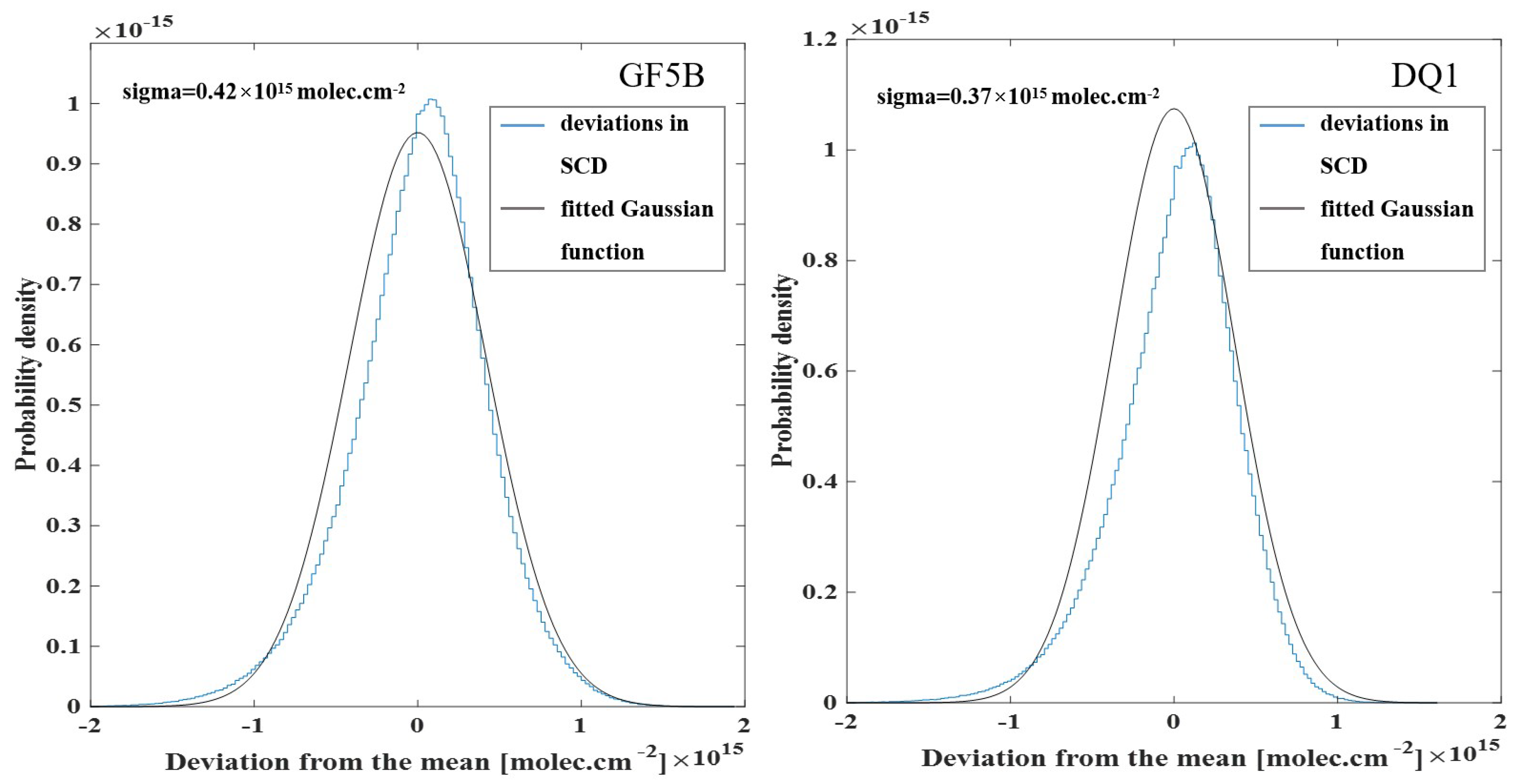
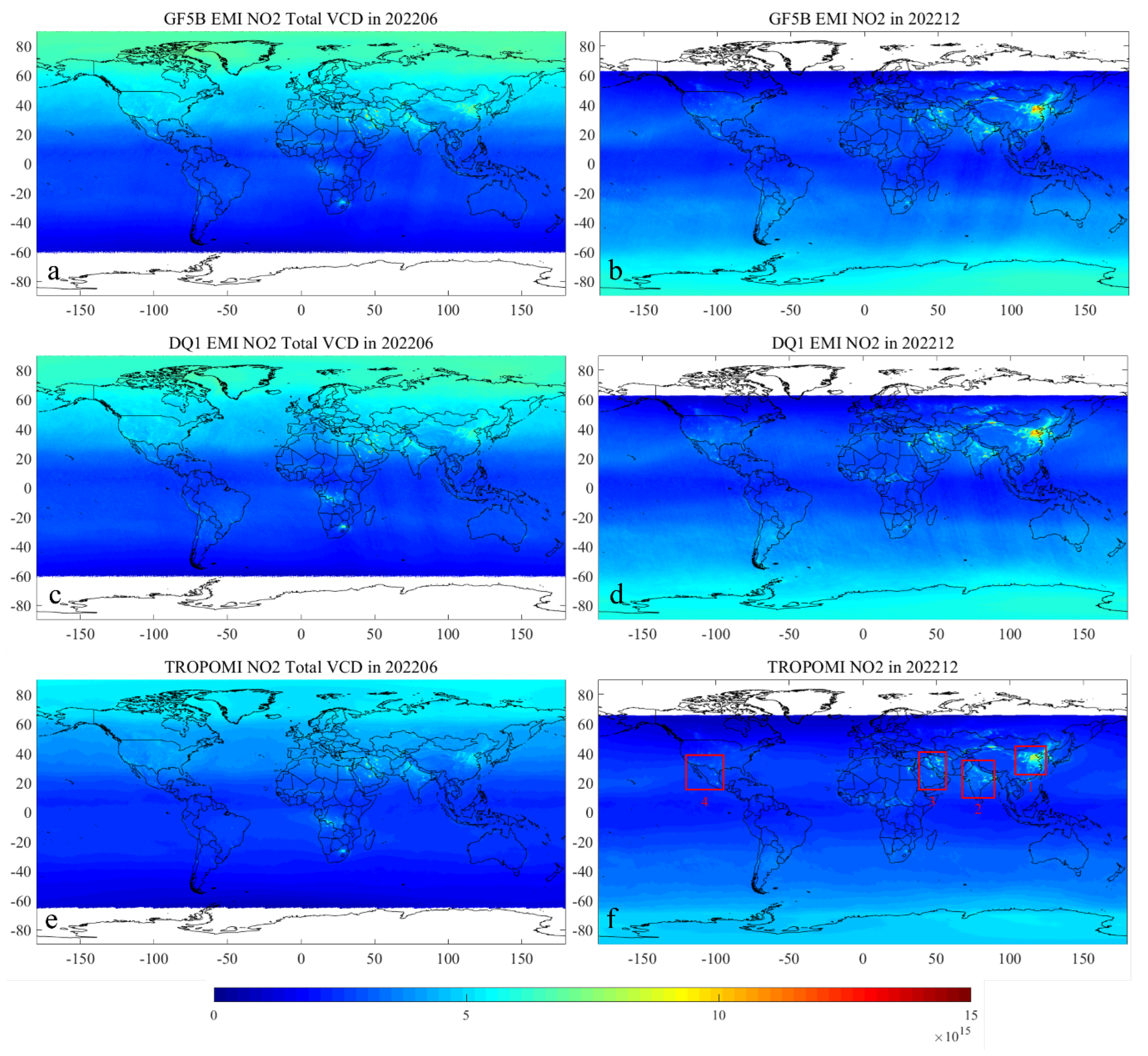
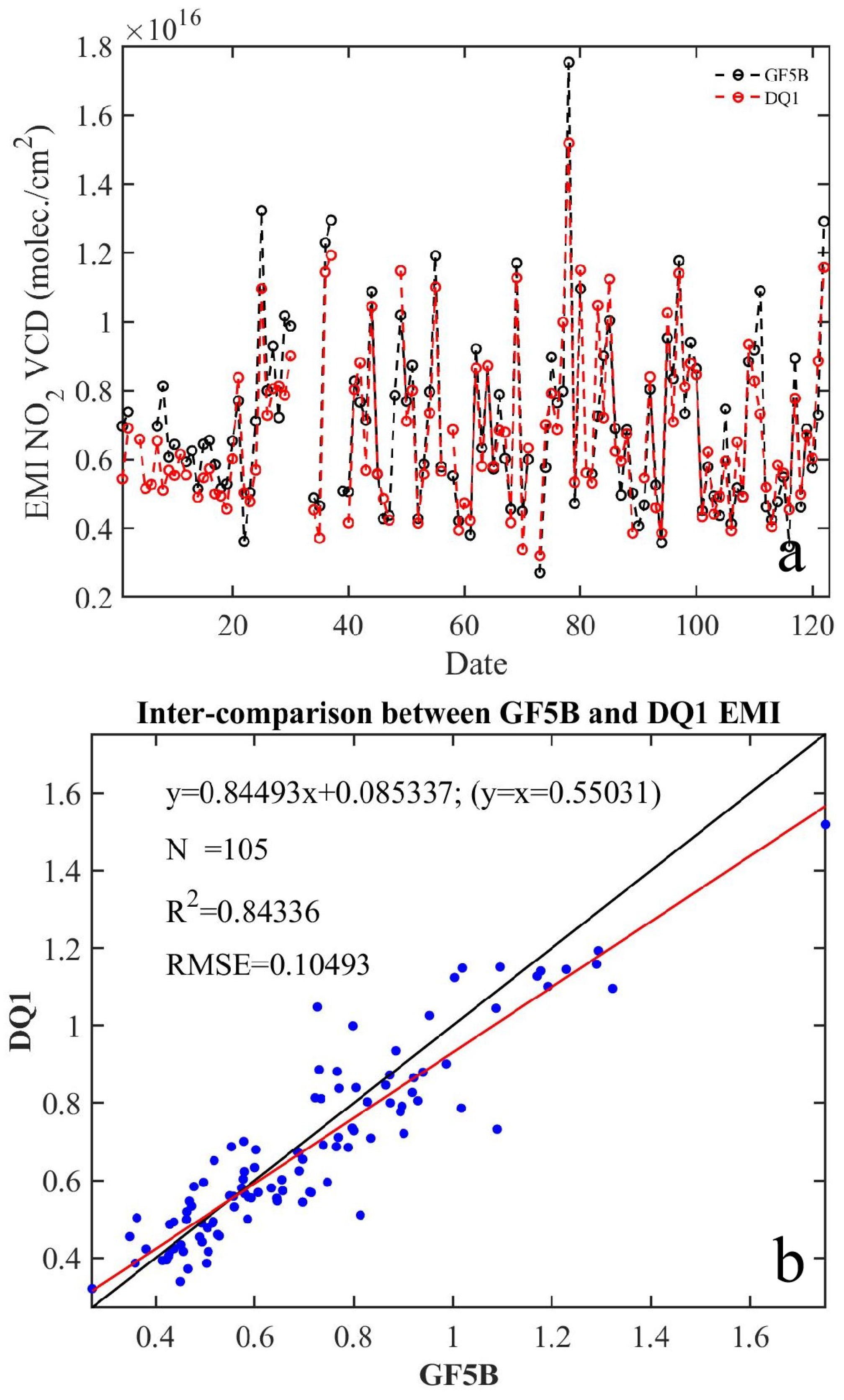


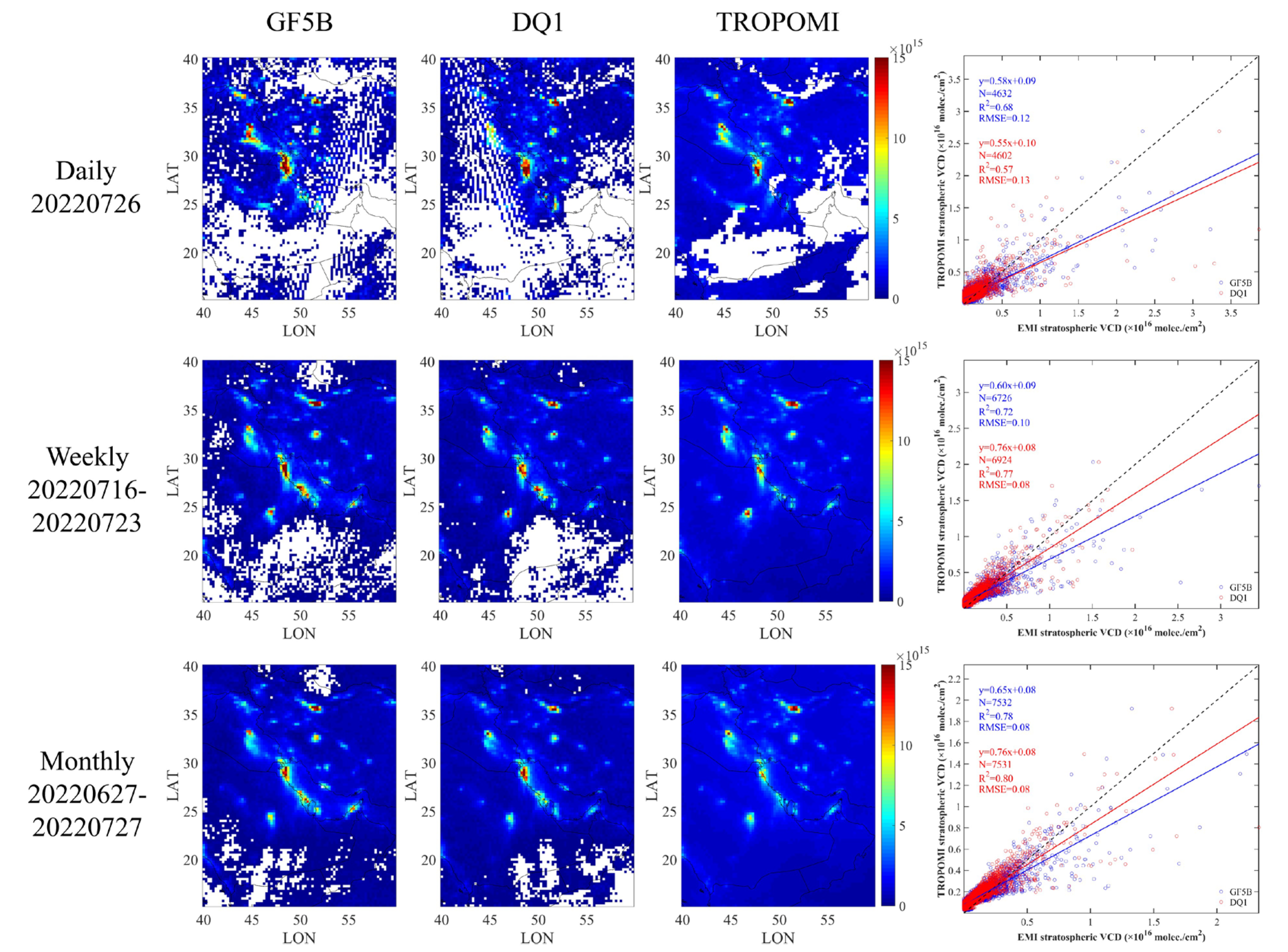
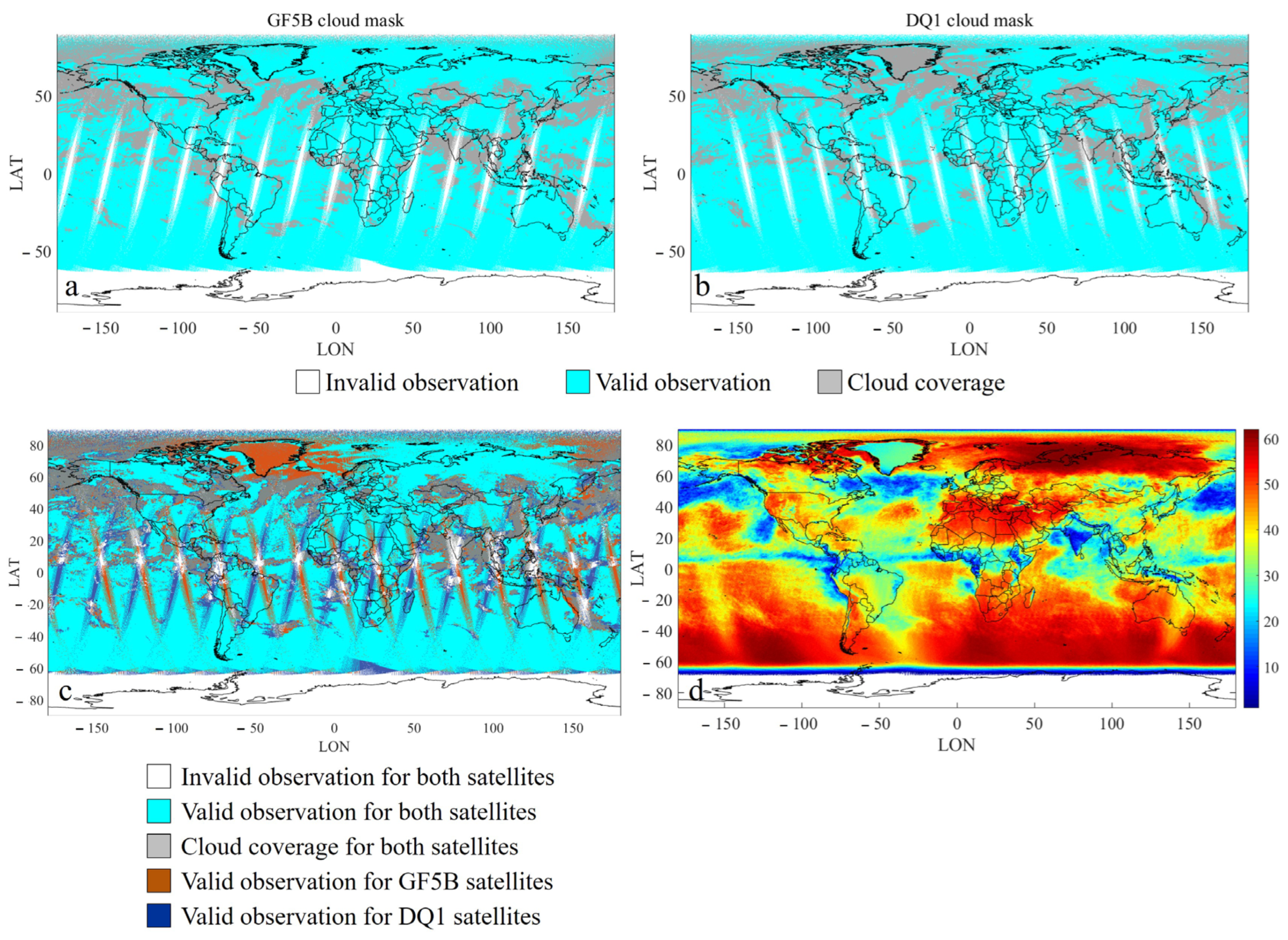
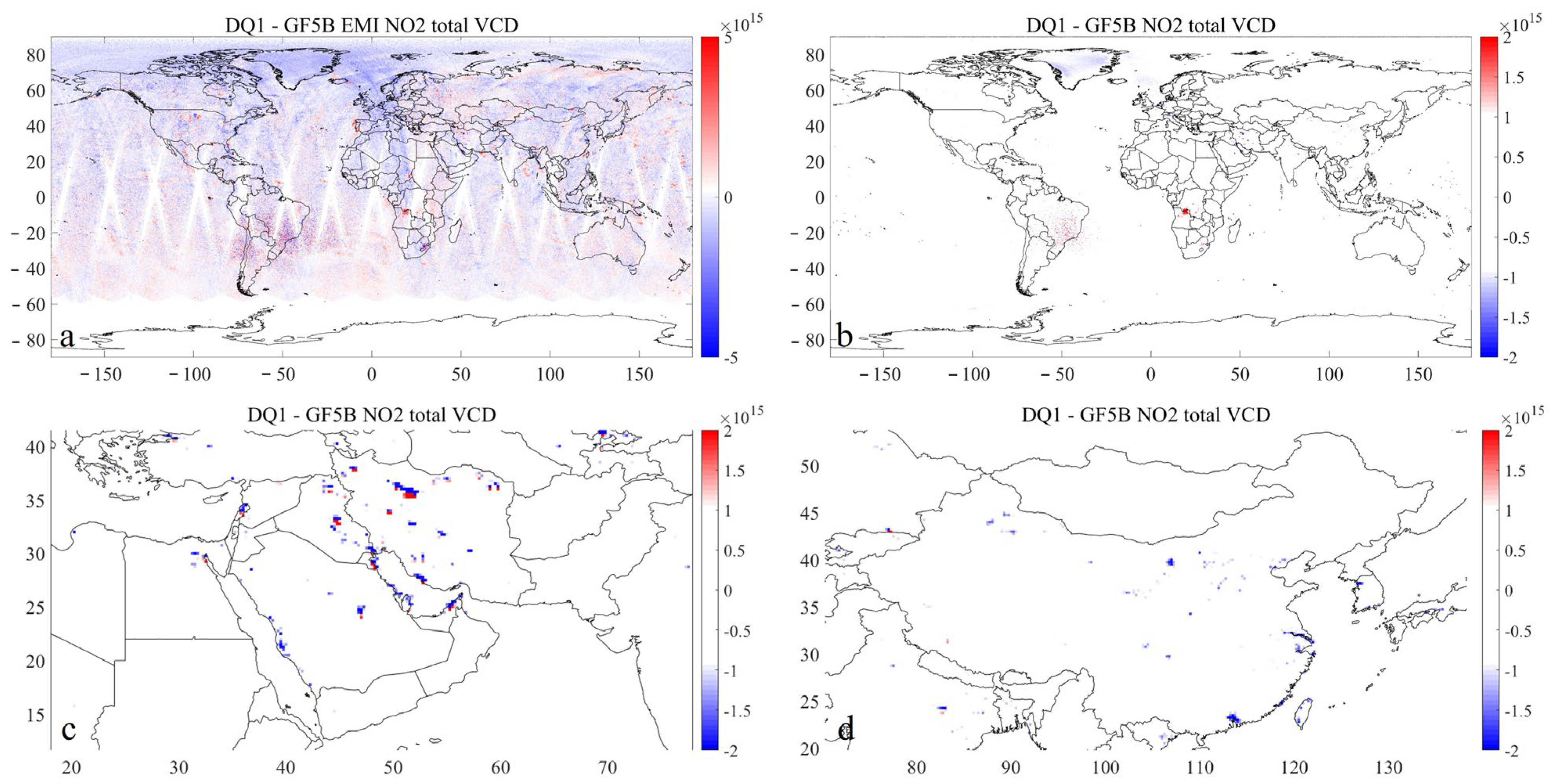
| Instrument Name | GF5 EMI | GF5B EMI-II | DQ1 EMI-II | TROPOMI | |
|---|---|---|---|---|---|
| Spectral range | UV1 band | 240 nm~315 nm | 240 nm~311 nm | 240 nm~315 nm | 270 nm~300 nm |
| UV2 band | 311 nm~403 nm | 311 nm~403 nm | 311 nm~403 nm | 300 nm~320 nm | |
| VIS1 band | 401 nm~550 nm | 403 nm~550 nm | 401 nm~550 nm | 310 nm~405 nm | |
| VIS2 band | 545 nm~710 nm | 550 nm~710 nm | 545 nm~710 nm | 405 nm~500 nm | |
| Spectral resolution | 0.3–0.5 nm | 0.3–0.6 nm | 0.3–0.6 nm | 0.5–1 nm | |
| Spatial resolution | 48 km × 13 km | 24 km × 13 km | 24 km × 13 km | 3.5 km × 5.5 km | |
| Equator crossing time | Ascending node 13:30 | Descending node 10:30 | Ascending node 13:30 | Ascending node 13:30 | |
| Parameters | GF5B EMI-II | DQ1 EMI-II | TROPOMI | |
|---|---|---|---|---|
| Fitting window | 405–465 nm | 405–465 nm | 405–465 nm | |
| Reference spectrum I0 | Irradiance measured on 8 October 2021 | Irradiance measured on 23 May 2022 | Annual mean (2005) solar reference | |
| Polynomial | 5th-order | 5th-order | 5th-order | |
| Included cross-sections | O3 | √ (223 K) | √ (223 K) | √ (243 K) |
| NO2 | √ (220 K) | √ (220 K) | √ (220 K) | |
| O4 | √ (293 K) | √ (293 K) | √ (293 K) | |
| H2O vapour | √ (280 K) | √ (280 K) | √ (280 K) | |
| H2O (liquid) | √ (295 K) | √ (295 K) | √ (295 K) | |
| Ring effect | √ | √ | √ | |
| Offset correction | √ | √ | × | |
| Region | 202206 | 202212 | ||
|---|---|---|---|---|
| R2 | RMSE | R2 | RMSE | |
| Region 1 | 0.91 | 0.03 | 0.93 | 0.04 |
| Region 2 | 0.92 | 0.03 | 0.86 | 0.03 |
| Region 3 | 0.85 | 0.04 | 0.85 | 0.04 |
| Region 4 | 0.94 | 0.02 | 0.75 | 0.02 |
Disclaimer/Publisher’s Note: The statements, opinions and data contained in all publications are solely those of the individual author(s) and contributor(s) and not of MDPI and/or the editor(s). MDPI and/or the editor(s) disclaim responsibility for any injury to people or property resulting from any ideas, methods, instructions or products referred to in the content. |
© 2024 by the authors. Licensee MDPI, Basel, Switzerland. This article is an open access article distributed under the terms and conditions of the Creative Commons Attribution (CC BY) license (https://creativecommons.org/licenses/by/4.0/).
Share and Cite
Cheng, L.; Wang, Y.; Yan, H.; Tao, J.; Wang, H.; Lin, J.; Xu, J.; Chen, L. Preliminary Global NO2 Retrieval from EMI-II Onboard GF5B/DQ1 and Comparison to TROPOMI. Remote Sens. 2024, 16, 4087. https://doi.org/10.3390/rs16214087
Cheng L, Wang Y, Yan H, Tao J, Wang H, Lin J, Xu J, Chen L. Preliminary Global NO2 Retrieval from EMI-II Onboard GF5B/DQ1 and Comparison to TROPOMI. Remote Sensing. 2024; 16(21):4087. https://doi.org/10.3390/rs16214087
Chicago/Turabian StyleCheng, Liangxiao, Yapeng Wang, Huanhuan Yan, Jinhua Tao, Hongmei Wang, Jun Lin, Jian Xu, and Liangfu Chen. 2024. "Preliminary Global NO2 Retrieval from EMI-II Onboard GF5B/DQ1 and Comparison to TROPOMI" Remote Sensing 16, no. 21: 4087. https://doi.org/10.3390/rs16214087
APA StyleCheng, L., Wang, Y., Yan, H., Tao, J., Wang, H., Lin, J., Xu, J., & Chen, L. (2024). Preliminary Global NO2 Retrieval from EMI-II Onboard GF5B/DQ1 and Comparison to TROPOMI. Remote Sensing, 16(21), 4087. https://doi.org/10.3390/rs16214087







